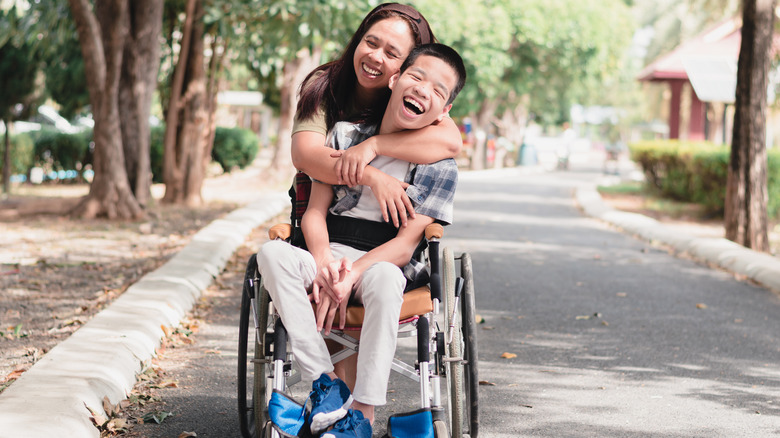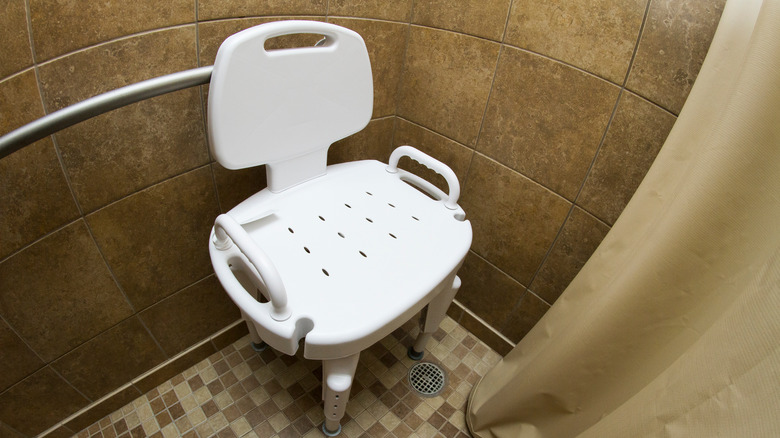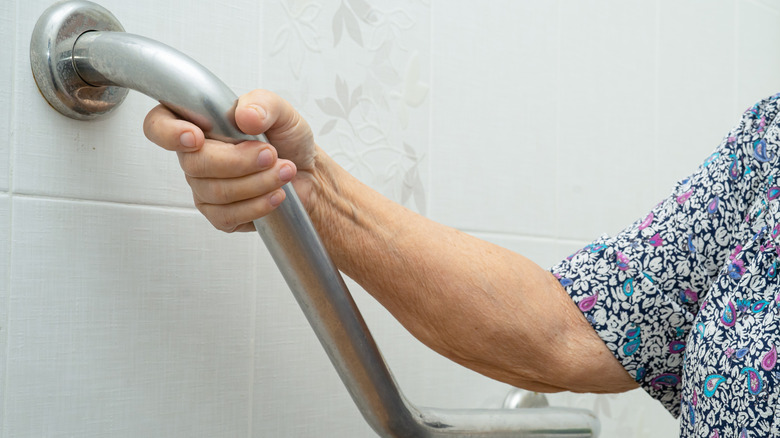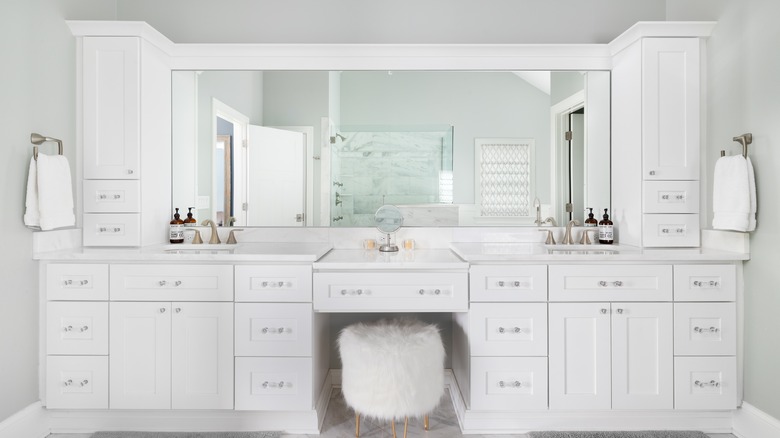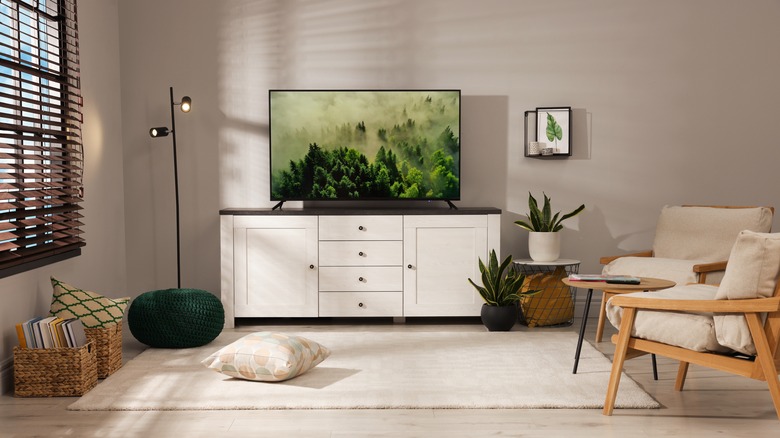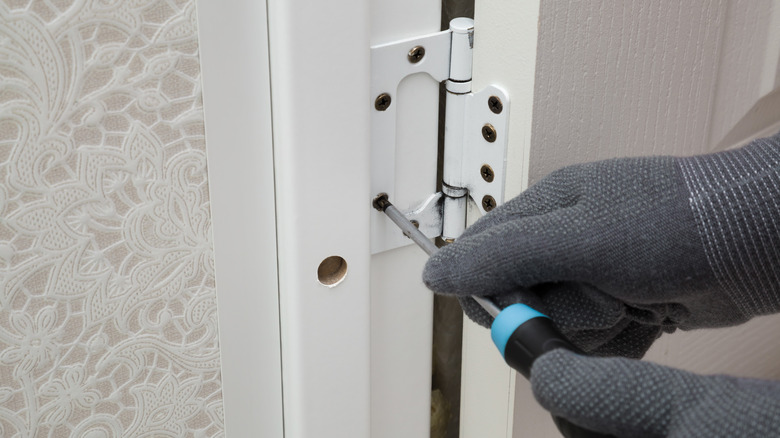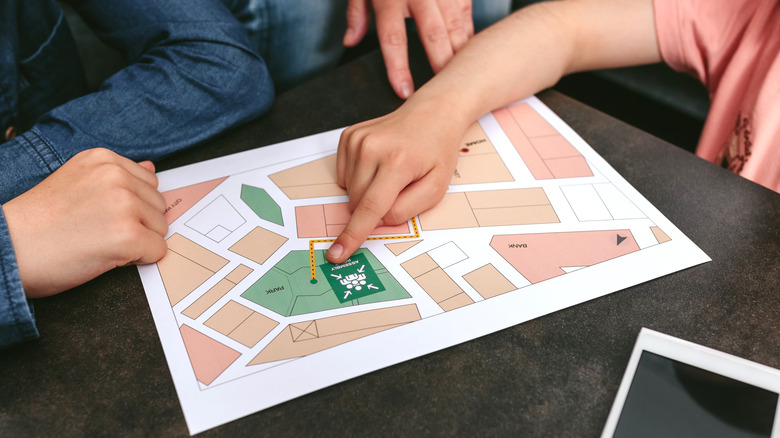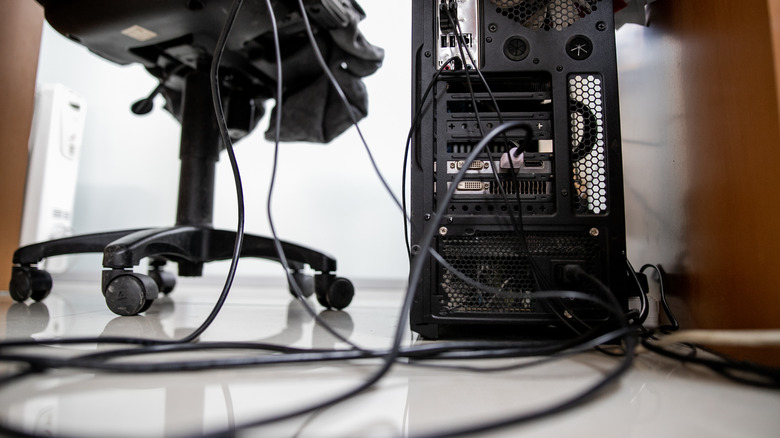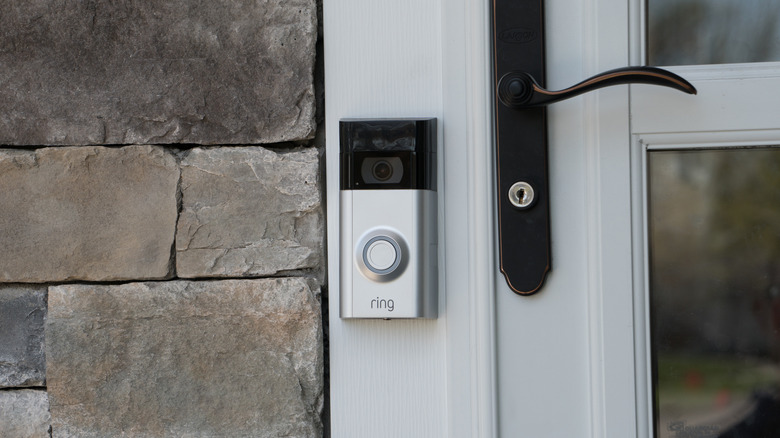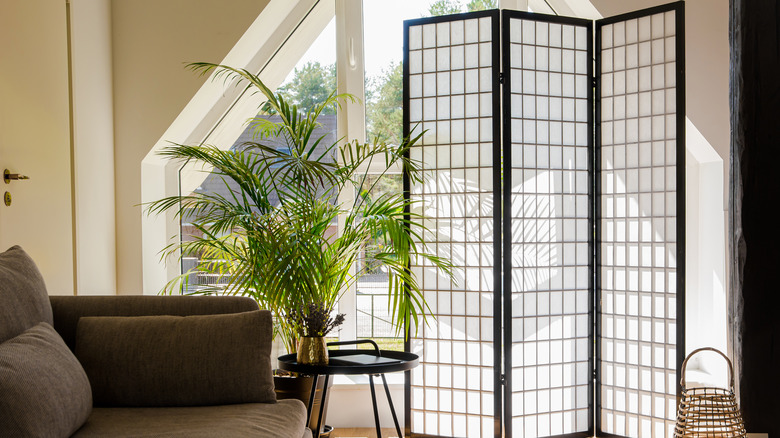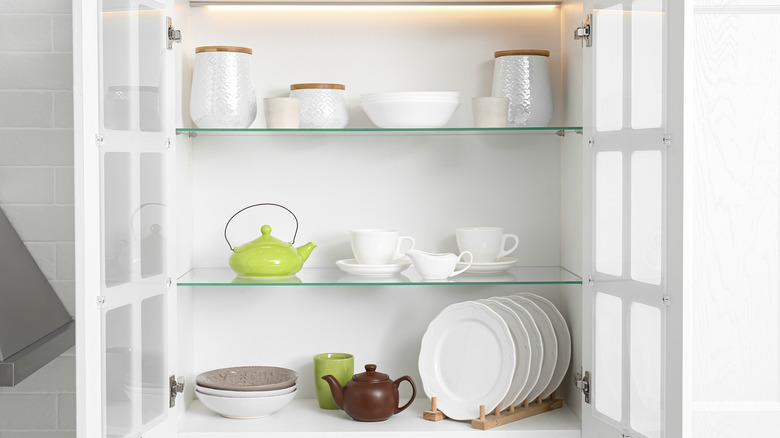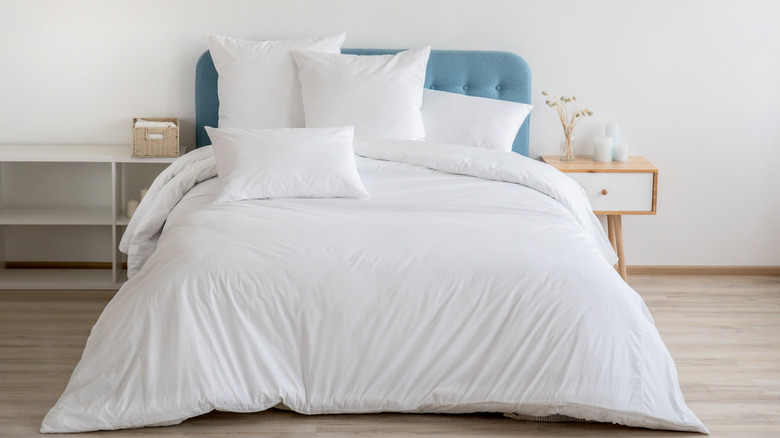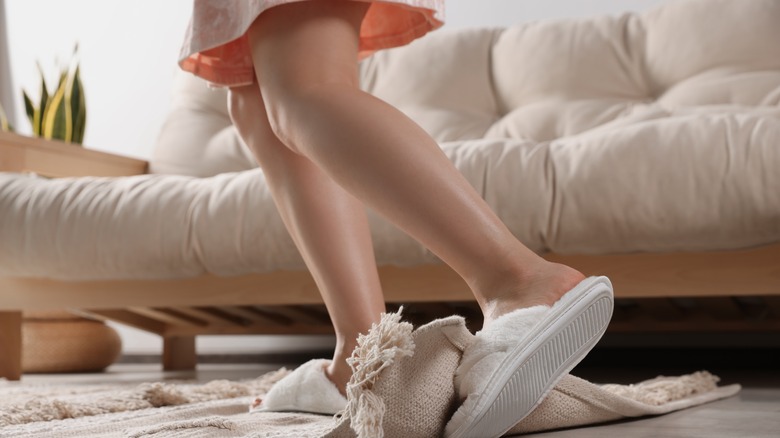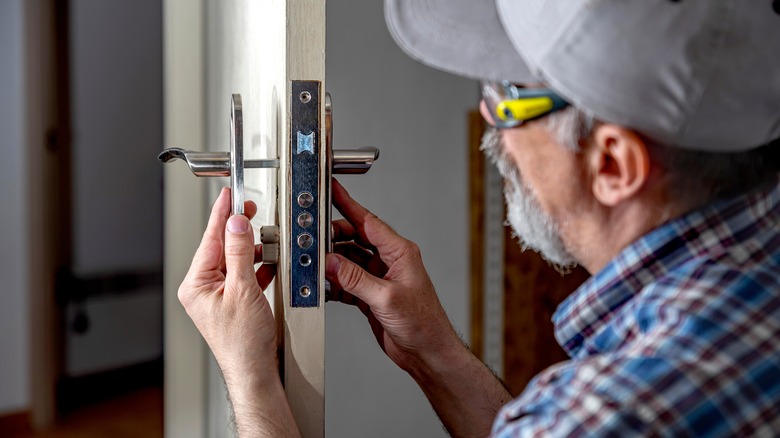Ways To Make Your Home More Accessible Without Renovating
According to the World Health Organization, over one billion people worldwide live with a disability of some kind. Every single one of us is likely to experience a disability during our lifetime, whether permanent or temporary. It's essential to have a home that can change with us as our needs evolve or accommodate guests in our home for everyone's overall comfort.
While doing large-scale renovations to transform our homes to suit our needs is the best-case scenario, it is often unrealistic. Construction can be expensive and take a long time to finish. If you or a loved one require a home that is more accessible, there are several things you can do today to make things pleasant and functional around the house — no construction necessary. There are plenty of easy ways to increase the accessibility of your home. You can complete most of these improvements in just one afternoon with a small budget and only one trip to your local hardware store.
1. Purchase a shower chair
If you are experiencing limited mobility, standing in the shower can be dangerous and exhausting. Often, shower design does not account for accessibility, and your shower may feel cramped and slippery. Expanding your shower to fix this problem requires expensive and time-consuming renovations. Instead, to avoid slipping and falling, or exhausting yourself, consider purchasing a chair for your shower. Sitting down while showering makes cleaning yourself easier and safer.
According to Endeavor Life Care, shower chairs improve results whether you are showering independently or with the help of a caretaker. When selecting a chair for your shower, consider your unique needs, as the chairs come in all shapes and sizes. If you need more support for your back, there are chairs with backs and arm grips. If you want more space when showering, shower stools are an option. Be sure to measure your shower before purchasing a chair to ensure that the one you choose will fit.
2. Install a balance bar next to the toilet
The bathroom can be a tricky place for those with limited mobility. However, setting up for your needs around the toilet can help you maintain your privacy. You might notice that standing up on your own after using the toilet is difficult, as is twisting around when cleaning yourself. To avoid falling or hurting yourself, consider adding a grab bar next to add stability and a bidet so that you don't have to reach or twist for toilet paper.
According to Senior Safety Advice, there are a few locations near the toilet for a grab bar. No location is better than another, and it's all about what works best for you. First, some find it helpful to install a bar next to the toilet on the wall — sort of like what you might see in an accessible public bathroom stall. Others prefer two bars, one on each side of the commode, as they find it easier to push themselves up with them there. You can purchase balance bars from most home improvement stores, or if you or someone you know is into DIY, you can create them at home with some PVC wipe and wood.
3. Consider adding more seating options around your home
According to Home Stratosphere, chairs are one of the most convenient pieces of furniture because they fit into such small spaces. If you are recovering from surgery or experiencing another health event, you might benefit from adding a few more chairs to your home. You may find that you become tired more often than you used to. To combat this and avoid exhaustion, you might need seats in places you ever imagined. This way, you can sit down to perform daily tasks and have a nearby place to rest — just in case.
It's typical for these extra seats to go near the kitchen sink so that you can sit down while washing your hands, dishes, fruits, and vegetables. Others might be in the laundry room, so you can fold clothes while seated, or under the bathroom vanity for applying makeup and brushing your teeth. You might want a temporary option, like a folding chair, or more stylish seating that matches the room's decor.
4. Evenly space furniture to create pathways
Overcrowded rooms make it more challenging to move around effectively with a mobility aid. You may find that as you navigate your home with your walker, cane, or wheelchair that it's frustrating when too much heavy furniture is in your way. Interior designer Abby Klatsky Interiors recommends that the minimum space between two pieces of furniture, even in a space not optimized for accessibility, should be at least 36 inches. If you are setting up your home for better movement, consider adding at least six inches to this.
Of course, this rule only applies to the furniture you need to move around or walk past. If you have two armchairs with a small table between them, then they don't need to be spaced out — no one was trying to go through there anyway. You might notice that as you begin spacing out your furniture, certain items become obsolete as there is no room for them. Consider donating these items or finding a place for them elsewhere in your home. There are a few more things you can do to items in your house to make it easier to navigate (via VIP Access). Little things like light switches and window blinds might be out of your reach. It doesn't require renovation to make them accessible. All you need to do is place a hook or cane near them, so you can tap and pull on things as needed.
5. Remove interior doors from their hinges
While we make our homes more accessible, not all of us have the option to complete the expensive and time-consuming remodeling process to expand our doorways. However, if we are in a pinch, we can make the thresholds easier to maneuver by removing the door itself. According to Accessible Systems, most doorways are anywhere from 22 to 30 inches wide. However, most mobility support items, like a cane, walker, or wheelchair, require about 36 inches to pass through comfortably.
Depending on your door size, removing the door can add about one or two inches to the frame. Removing the door means you don't have to fight against something pushing back while you make your way through. If you want to maintain the privacy of a closed door, you can also purchase expandable door hinges at most home improvement stores. When you apply pressure to a door with these hinges, it's similar to taking the door off.
6. Enhance the appearance of exits
You need to have a clear exit from your home in an emergency for all guests and residents. All public places have clear exit signs, and businesses have plans to ensure everyone gets out of the building safely. The same should be thought of in advance at home to avoid tragedy. According to University of California San Diego, the preparations you will need to make for your emergency action plan depend on those involved. For example, if you or a family member are blind, you will need different accommodations than someone using a wheelchair.
The key is to gather as a household and make a plan well in advance of anything happening. Make sure the exits from your home are marked (with lights or devices that make sound) and usable for everyone. You can achieve this by installing expandable door hinges, building a wooden ramp, or using a large door handle. If you or your family member need more help during an evacuation, think about who will be responsible for this ahead of time.
7. Gather up lose cords to avoid the tripping hazard
Loose cords present several challenges in and around the home. While some might think they are a bit of an eyesore that ruins the visual appeal of a room, all will agree that they are dangerous tripping hazards. According to ServiceMaster Restore, if you manage the cords in your home correctly, you can save yourself from a nasty fall, fire hazards, or the risk of electric shock.
To make your home a bit safer and more accessible, look at high-traffic areas of your home. Are there any loose cords in the vicinity? While some experts might advise you to tape these cords down to the floor, that does not work as well if you use a mobility aid, as they are still in the way. Consider taping or attaching your loose wires up against the wall instead. Keep them flush with the wall, or run them over the tops of the baseboards if they are on the floor.
8. Install a video doorbell
According to Android Central, if you install a video doorbell, you can avoid a trip to the door if you are experiencing limited mobility. In today's modern age, there is no reason to struggle to the door only to find out it's a solicitor or neighbor you're trying to avoid. Instead, a video doorbell allows you to see who is there and speak to them without needing to get up. Video doorbells are also great for people with hearing issues, as you can get an alert on your phone that someone is at the door instead of listening for the knock.
These doorbells, like the popular brands Ring and Nest, are sold at most local big box stores, like Walmart or Best Buy. They don't take much to set up and connect to your home's WiFi. Their benefits extend well outside of the home. You can see if anyone is around your front porch, even if you aren't at the house.
9. Set up a temporary ground floor living space
If you have surgery or experience another temporary health event, you might find that navigating stairs is out of the question. If you live in a home with more than one floor, it's possible to turn a communal space into a private resting space downstairs. According to The Inside, one of the first things to do is purchase a small room divider. While they don't muffle any noise, the dividers provide visual privacy for dressing and sleeping. You can find them in all shapes, sizes, and colors at most stores that sell furniture, as well as secondhand. A bookcase or two can do the trick if you don't want to purchase something new.
A pull-out couch isn't very comfortable while you are recovering. So, depending on how long you need to stay downstairs, your family might consider disassembling your bed and reassembling it in your new space. If your bed doesn't fit, purchase a smaller, comfortable bed.
10. Rearrange your kitchen and place heavier items lower
For some, lifting items above your head can cause dangerous muscle strain, discomfort, and dizziness. When thinking about making your home easier to use, it's all about ensuring that the things you use are easy to access. Since we spend so much time in our kitchens, it's essential to make an effort to reorganize them to include all household members. According to AIP Builders, the ideal height to store something for someone using a wheelchair is between 15 and 48 inches from the ground. This way, they don't have to bend or twist awkwardly to access things.
The key to achieving this without renovation is to take note of what is stored where. For example, move the crockpot you only use every once in a while to a top shelf, while the plates and cups you use for dinner each night are in the lower cabinet. If you need more room, consider adding a stylish bar cart to your kitchen for extra storage.
11. Purchase a different bed frame, according to your needs
Our needs for a good night's sleep can vary, especially when it comes to getting in and out of bed and resting comfortably on the mattress. If you struggle to get in and out of bed, consider purchasing a new bed frame. Some find that an adjustable bed frame is a good fit, as you can adjust the height accordingly. The same is true for a mattress. If you feel like you are drowning in your bed because it gives way, purchase a firmer mattress. You deserve to be comfortable.
According to Mattress Clarity, the typical bed frame requires a box spring. Taking the box spring out automatically lowers the bed by about 12 inches. If you need to lower your bed, removing the box spring might save you the space you need. The best height is where your knees are about 90 degrees when sitting at the edge of it. For most, this is between 16 to 24 inches, just to give you a picture while you shop for the best fit.
12. Remove rugs and doormats
Often, rugs and carpets can be frustrating for those using a wheelchair, walker, or cane. You'll find that as you move across the floor, the edges of the fabric usually get caught under your device, creating a trip and fall hazard. According to Stepping Thru Accessibility, you need to secure rugs in public spaces to the floor to comply with the Americans with Disabilities Act. You can consider taping a rug down at home, but it doesn't always look the best. In addition, you will need to tape down the entirety of the rug. If you only tape the corners down, the sides will still impede mobility.
The easiest thing to do is to remove the smaller rugs and doormats so nobody trips and hurts themselves. If you would like to keep them, make sure they are not in an area of high traffic (like a hallway) and are instead somewhere where everyone is less mobile (like under a couch and coffee table).
13. Swap out door knobs for door handles
Door handles can be easier to use than door knobs for many people, as a door knob requires more force and dexterity to grip and twist than a door handle. According to interior designer Laurel Brinson, if you don't want to swap out every door knob in your house, you can purchase door knob adapters. These adapters add bulk to the door knobs, so there is more usable surface area. In addition, door knob adapters ensure that gravity works with the user to open the door instead of relying on wrist mobility. You can purchase adapters online or at most local home improvement stores.
In addition, door handles make things easier for each household member. Someone with full hands can press down on the handle with their arm or elbow and walk straight through instead of having to shuffle things around to free up a hand.
